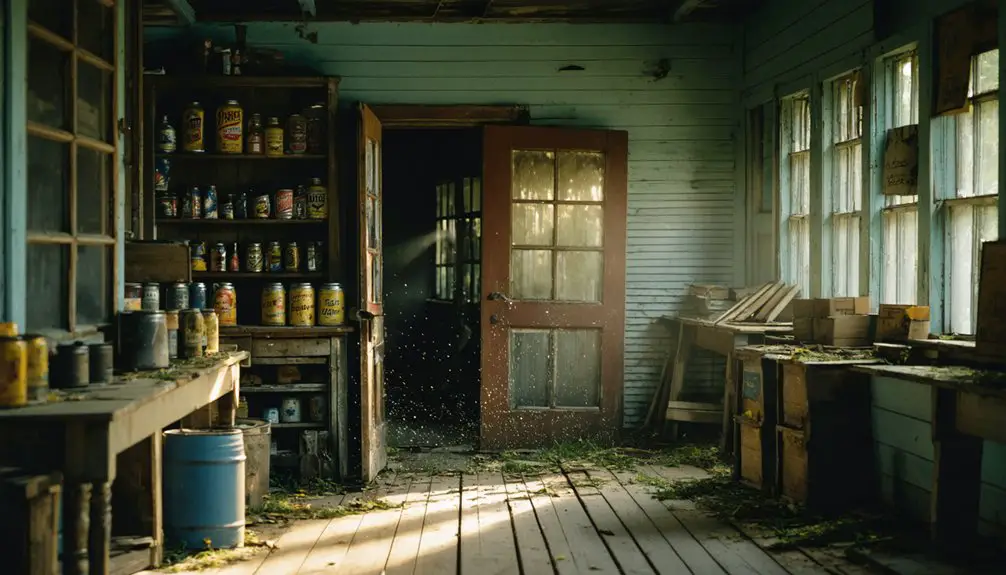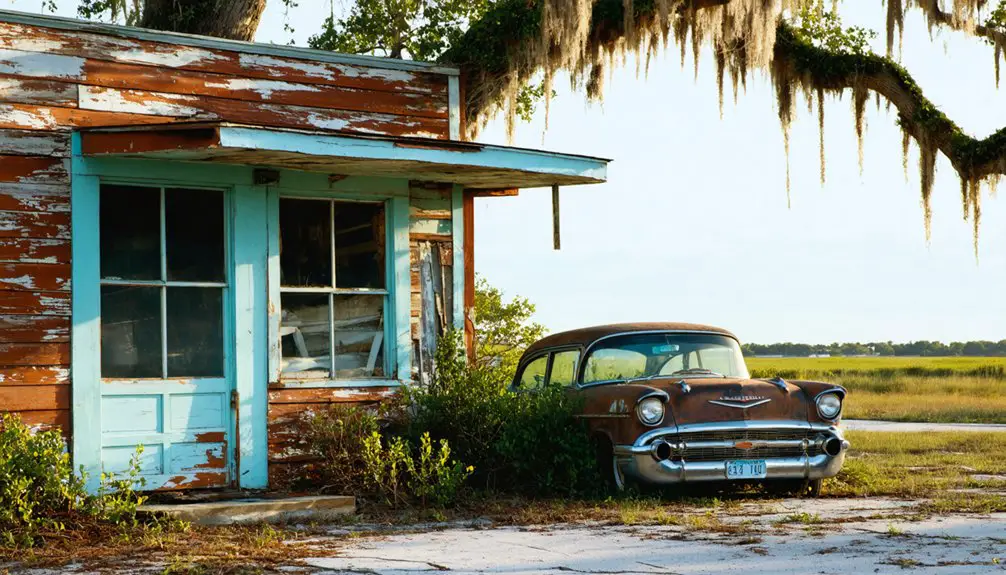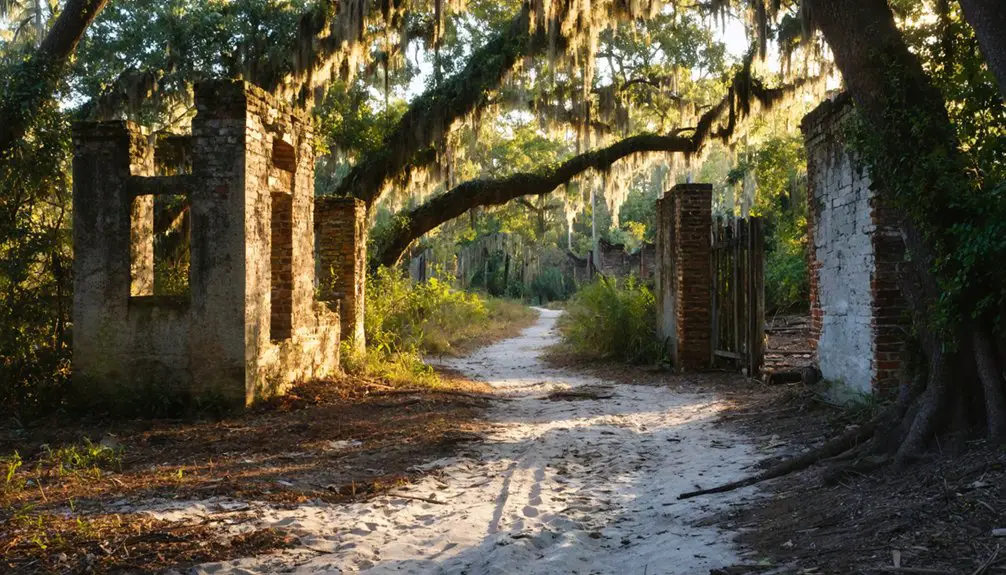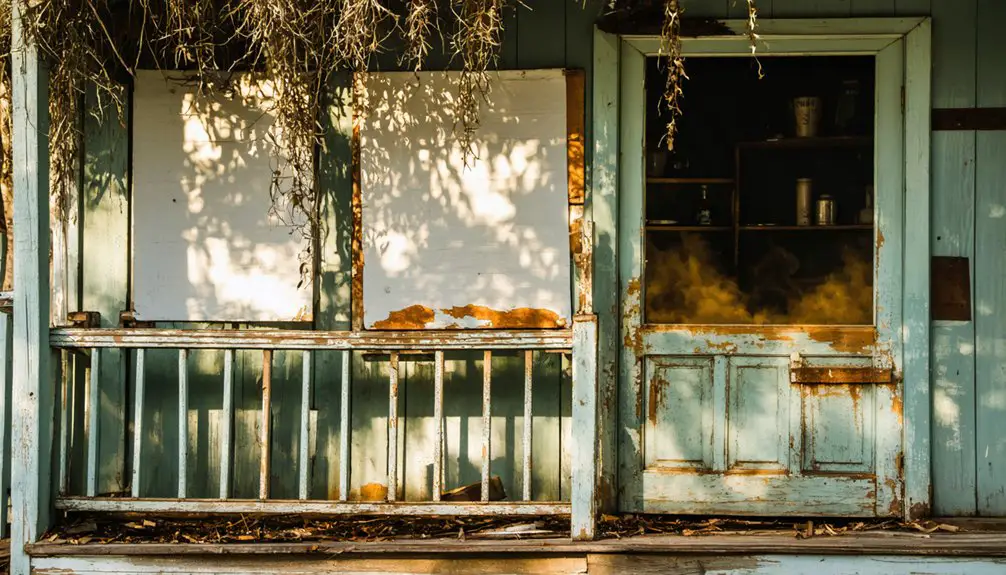You’ll find Wilson at the southern tip of Florida’s Lake Wales Ridge, where a once-thriving lumber town operated until the 1960s. This ghost town‘s history spans from its 1894 founding through its sawmill heyday, when mills processed over 250,000 board feet annually. Natural disasters and economic decline gradually emptied the community, but its final transformation came with NASA’s Kennedy Space Center development. The story of Wilson reveals an unexpected connection between America’s timber industry and space exploration.
Key Takeaways
- Wilson was a former lumber town in Florida that became abandoned after economic decline and natural disasters in the early 1900s.
- The town’s final demise came with the establishment of Kennedy Space Center in the 1960s, requiring demolition within the launch facility radius.
- Originally thriving on timber production, Wilson’s sawmills processed over 250,000 board feet annually during its peak operations.
- The town’s infrastructure, including its post office and railroad connections, gradually disappeared as residents left for better opportunities.
- No original structures remain today, with the area now restricted due to federal regulations and surrounded by natural preserves.
Early Settlement and Origins
While Florida’s Lake Wales Ridge descends into the Everglades, the ghost town of Wilson once thrived at its southernmost tip.
You’ll find its history rooted in the “Red Hills” region, where sugar sand mixed with moisture-retaining red clay created prime conditions for agriculture and freeze-resistant citrus groves.
The first non-native settler challenges began around 1894 when James Carlton’s family carved out a life in this wilderness.
By 1917, only five families had officially settled in the area, then known as Hicoria – named for the local scrub hickory studied by botanist Dr. John Conkle.
These pioneers faced considerable isolation, with just the sandy Footman Trail connecting them to civilization. Atlantic Coast Railroad arrived in 1914, bringing new opportunities for growth and connection to the outside world.
Without railroads or waterways, early agricultural practices remained limited to sustaining the small community of squatters, farmers, and cattle ranchers who called this frontier home.
The local wildlife was abundant, with settlers frequently encountering panthers and bears in the untamed wilderness.
The Lumber Industry’s Golden Era
As transportation networks expanded across Florida in the early 1800s, Wilson’s abundant pine forests caught the attention of ambitious lumber companies. You’d find steam-powered sawmills transforming the landscape, their circular saws slicing through longleaf pines with unprecedented efficiency.
These technological advancements revolutionized lumber production, enabling mills to process over 250,000 board feet annually by the mid-1830s. In 1829, the region saw the establishment of its first steam sawmill operation in eastern Florida.
Steam-powered innovation transformed Florida’s lumber industry, as mills reached groundbreaking production levels of 250,000 board feet each year.
During the industry’s peak in 1909, Florida’s lumber production soared to 1.25 billion board feet, with Wilson’s mills contributing to this boom. Local families owned many of these operations, providing seasonal employment to nearby residents. Workers endured challenging conditions, earning just 13.67 cents per hour in 1907.
The mills weren’t just businesses; they were community lifelines, shaping Wilson’s development until resource depletion and changing markets led to their eventual decline by mid-century.
Transportation and Infrastructure
You’ll find that Wilson’s transportation network was heavily influenced by Florida’s expanding railroad systems of the early 1900s.
The town’s position along established rail lines enabled efficient movement of lumber products from its mills to markets across the state. The Orange Belt Railway played a crucial role in connecting the area to other developing Florida communities. Local craftsmen constructed wattle fences from willow branches to help control erosion along the rail lines.
While road networks remained primitive during Wilson’s peak years, the rail connections and nearby waterways provided essential transport infrastructure for both industrial operations and basic supplies.
Road Network Connections
Although Wilson’s ghost town status suggests isolation, the area maintains significant transportation connections through Florida State Road 3 (FL 3), which serves as the primary route linking the region to nearby communities.
You’ll find road maintenance varies throughout the area, with traffic patterns remaining relatively light except during special events or construction activities. The presence of grass between cracks in many roadways reflects years of neglect and abandonment. The intersection at Wilson’s Corner once featured a bustling lumber yard that served as a major transportation hub for the region.
Key aspects of Wilson’s road network include:
- Direct access to boat ramps and recreational areas via Taylor Road
- Connection to regional transportation hubs through FL 3 and FL 402
- Historical remnants of abandoned streets gradually being reclaimed by nature
- Potential for infrastructure improvements due to planned Civilian Space Port development
These connections, while limited by the area’s ghost town nature, continue to serve essential transportation needs for remaining facilities and future development possibilities.
Rail and Water Access
While Wilson’s early development relied heavily on transportation infrastructure, its rail and water access systems have largely disappeared over time.
Like many Florida ghost towns, Wilson’s railroad significance stemmed from the narrow-gauge railways that served local industries, particularly logging operations. These rail connections were essential to the town’s economic survival, integrating it into Central Florida’s broader transportation network. Today, visitors can experience similar historic rail operations at the Florida Railroad Museum in Parrish.
You’ll find that waterway economy played a fundamental role in sustaining communities like Wilson. Similar to nearby Markham near Lake Eustis, access to waterways supported agricultural activities and transportation needs.
However, Wilson’s fate mirrored that of other ghost towns – when the railroad operations ceased and industrial activities declined, especially after the Great Depression, the town’s infrastructure fell into disuse, leaving only traces of its transportation heritage.
Natural Disasters and Economic Setbacks
When natural disasters struck the small Florida town of Wilson in the late 1800s, its fate as a ghost town began taking shape.
The community’s social resilience was tested by multiple catastrophes, while its economic dependency on the lumber industry proved devastating when the sawmill burned down in 1898.
A town’s strength lies not just in its industry, but in its ability to overcome repeated hardships and rebuild from disaster.
Similar to other timber settlements that experienced no replanting efforts, Wilson’s natural resources were gradually exhausted without sustainable forest management practices.
You’ll find that Wilson’s decline was marked by these critical setbacks:
- The sawmill fire destroyed the town’s primary employer and economic engine
- Repeated flooding made the area increasingly uninhabitable
- Timber resources were depleted with no significant replanting efforts
- The Great Depression delivered the final blow to any recovery hopes
These combined challenges proved insurmountable for Wilson’s residents, who gradually abandoned the town in search of more stable opportunities elsewhere.
Life in Wilson’s Corner

If you’d lived in Wilson’s Corner, you’d have found your daily routine centered around the bustling lumber yard, where workers processed timber from Florida’s dense forests.
You’d have joined your neighbors each morning walking or driving to work along the junction of FL 402 and FL 3, where the lumber yard served as the community’s economic backbone.
The workday would’ve been filled with the sounds of sawing wood and the steady movement of lumber, while other residents operated small businesses that supported the workforce’s daily needs.
Daily Community Activities
Despite its small size, Wilson’s Corner maintained a vibrant community life centered around the junction of FL 402 and FL 3. Daily routines revolved around the general store area, where you’d find locals exchanging news and trading goods.
Community gatherings often occurred near the lumber yard’s loading docks, where residents shared stories and supported one another through informal barter systems.
Living in Wilson’s Corner meant embracing a self-reliant lifestyle where you’d:
- Trade locally produced items at the general store while catching up on community news
- Share labor and skills with neighbors for home maintenance and seasonal harvests
- Meet fellow residents at outdoor gathering spots for face-to-face communication
- Participate in informal religious activities and celebrations held in homes or communal spaces
Work at Lumber Yard
As the economic backbone of Wilson’s Corner, the Wilson Lumber Co employed skilled workers to process hardwood for automobile parts and radio cabinets throughout the late 1920s and early 1930s.
You’d find a diverse workforce managing heavy logs and operating specialized equipment in the bustling lumber yard, where precision cuts and assembly-grade finishes were essential for manufacturing partnerships with Graham-Paige Motor Car Co and Philco Radio.
The workforce dynamics reflected the era’s mobile nature, as you’d see skilled laborers, including African-American communities, following timber operations across Florida.
You’d witness workers tackling dangerous conditions while operating sawmills, managing drying sheds, and preparing timber for shipment via nearby railways.
This continued until the 1940s when fire destroyed the yard, after its acquisition by the Granger Brothers.
The Great Depression’s Impact
When the Great Depression struck in 1929, Wilson’s fate as a ghost town became increasingly sealed. Despite attempts at community resilience and economic adaptation, the town faced insurmountable challenges that ultimately led to its demise.
The devastating impact of the Depression manifested in several significant ways:
- The local timber industry collapsed, shuttering the essential sawmill operations.
- Agricultural failures, particularly in citrus crops, eliminated important income sources.
- Railroad service reductions isolated the community from necessary supply chains.
- The closure of the post office marked the final blow to the town’s infrastructure.
As younger residents fled to urban areas seeking better opportunities, Wilson’s population dwindled rapidly. The aging community couldn’t sustain basic services, and maintenance costs became unbearable as the tax base shrank, leading to the town’s eventual abandonment.
Space Age Transformation

The emergence of the Kennedy Space Center on Florida’s Merritt Island in the 1960s marked a dramatic reversal of fortune for the region.
You’d have witnessed an unprecedented transformation as the space exploration hub brought massive infrastructure projects, including the iconic Vehicle Assembly Building and Launch Complex 39.
The once-quiet area buzzed with new energy as thousands of workers flocked to Brevard County.
The impact reached far beyond the center’s boundaries.
The Kennedy Space Center’s influence rippled through the entire region, reshaping communities and forever altering Florida’s Space Coast landscape.
You’d have seen entire communities spring up as housing developments and businesses emerged to support the growing population.
The space age brought not just jobs but a complete reimagining of the local economy.
Community development expanded rapidly with new schools, roads, and services, while the center’s visitor complex turned the area into a tourist destination, forever changing the region’s character.
Neighboring Ghost Towns
Several ghost towns dot the landscape surrounding Wilson and Merritt Island, each telling a unique story of Florida’s past.
Your journey through these forgotten communities reveals important lessons in ghost town preservation and community remembrance.
- Shiloh’s abandoned streets and parking lots, now claimed by nature, stand preserved due to delayed spaceport development plans.
- Fort Dade’s ruins on Egmont Key remain accessible by ferry from Fort DeSoto Park, where 300 residents once guarded Tampa Bay.
- Fort Drum’s cemetery serves as a memorial to early settlers and cattle ranchers who shaped Florida’s frontier.
- Hampton Springs’ remnants showcase a once-bustling health resort, where visitors sought healing in natural spring waters.
These vanished towns reflect diverse causes of abandonment – from space program expansion to changing economic fortunes – each preserving a unique chapter of Florida’s heritage.
Historical Maps and Documentation

You’ll find Wilson’s most notable landmarks clearly marked on maps from 1926, including the historic Oakdale Cemetery, Grabneck neighborhood, and several educational institutions like the Colored Graded School and Darden High School.
Through state highway maps and property surveys, you can trace Wilson’s transformation from a thriving community to its eventual abandonment during NASA’s Kennedy Space Center construction in 1962.
Florida’s preservation efforts have maintained these historical maps in state archives and the Florida Master Site File, providing essential documentation of Wilson’s layout and development before its disappearance.
Pre-1950s Map Features
Historical maps from 1926 and 1956 provide essential documentation of Wilson’s location at the intersection of County Road 402 and Kennedy Parkway, formerly known as FL 3.
You’ll find cartographic symbols marking “Wilson’s Corner” as a notable landmark before the Kennedy Space Center’s development transformed the landscape.
These critical pre-1950s maps reveal:
- Road networks connecting Wilson via FL 3 and local thoroughfares
- Natural features including wetlands, forests, and waterways
- Town layout with street grids and historical landmarks like cemeteries
- Property boundaries and land plots essential for genealogical research
The preservation of these maps in state archives and libraries offers irreplaceable insights into Wilson’s layout before its 1960s razing, showing how the town existed within its natural environment.
Cartographic Preservation Methods
Because preserving Wilson’s cartographic heritage requires specialized techniques, archivists employ both digital and physical conservation methods to protect the town’s historical maps.
You’ll find these maps stored in controlled environments at 65-70°F with 30-50% humidity, using acid-free materials to prevent deterioration. Digital preservation has made it possible for you to access these historical documents online without handling the delicate originals.
Conservation techniques include carefully removing old varnish and repairing tears or creases while maintaining the maps’ original appearance.
Specialists use de-acidification products like Bookkeeper to neutralize paper acidity, particularly important for 19th-century documents. They’ll also remount maps using archival-quality materials and store them either flat or carefully rolled to prevent damage, ensuring Wilson’s cartographic history remains intact for future generations.
Legacy and Modern-Day Status
The legacy of Wilson, Florida persists primarily through its connection to America’s space program, as the town’s fate became inextricably linked to the Kennedy Space Center’s establishment in the early 1960s.
Wilson’s legacy now stands as a memorial to the sacrifices made in pursuit of space exploration, with its original site marked only by the intersection of CR 402 and Kennedy Parkway.
Today, you’ll find:
- No original structures remain, as all buildings were demolished within the launch facility’s debris radius
- Limited public access to the area, restricted by federal regulations
- Dirt roads that offer glimpses of where the lumber town once thrived
- The junction marking Wilson’s former location, now surrounded by natural preserves and waterways
Frequently Asked Questions
What Happened to the Families Who Were Forced to Relocate?
Like deleting your Instagram followers, relocation impacts shattered your family’s social networks. You’d seek new communities near railroads, adapting to unfamiliar towns while your family histories faded into ghost-town memories.
Were Any Artifacts From Wilson Preserved in Local Museums?
You won’t find documented evidence of artifact preservation from Wilson in local museums, though there’s potential that some families may have donated personal items that weren’t specifically labeled as Wilson artifacts.
What Was the Peak Population of Wilson During Its Heyday?
You’re looking at a likely peak population of 200-300 residents during Wilson’s historical significance before population decline, though exact numbers aren’t recorded. Similar towns in Highlands County showed comparable peaks.
Did Any Original Buildings Survive the Kennedy Space Center Development?
You won’t find any historical preservation of Wilson’s original buildings – they were cleared away during KSC’s development. Despite their architectural significance, these structures gave way to NASA’s modern space center facilities.
What Indigenous Communities Lived in the Wilson Area Before Settlement?
You’ll find the Apalachee were the primary indigenous tribes in this region, with their cultural heritage centered on agriculture and water-based settlements, before Creek Indians (later Seminoles) migrated there around 1700-1840.
References
- https://www.tiktok.com/@socialshepherdadventures/video/7342301852702100778
- http://www.gribblenation.org/2018/02/ghost-town-tuesday-ghost-towns-of.html
- https://www.youtube.com/watch?v=ov9YSsKtbDs
- https://en.wikipedia.org/wiki/List_of_ghost_towns_in_Florida
- https://www.wikiwand.com/en/articles/List_of_ghost_towns_in_Florida
- https://floridahistoryblog.com/hicoria-florida/
- https://www.clickorlando.com/news/local/2025/03/06/exploring-the-ghost-town-of-markham-in-seminole-county/
- https://www.youtube.com/watch?v=DKesRivP9VU
- https://floridatrailblazer.com/2017/06/21/markham-ghost-town-in-seminole-county/
- https://www.fnai.org/arrow-site/history/history-forestry



